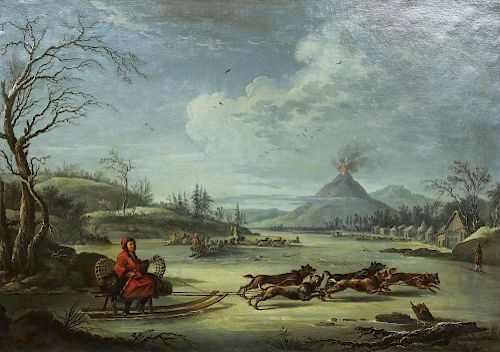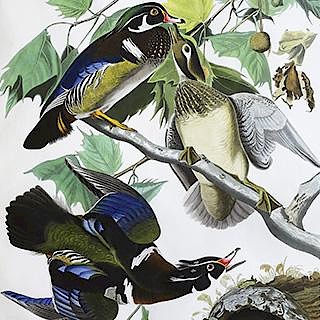John Webber, Winter Scene in Kamchatka Oil Painting
Lot 105
About Seller
Arader Galleries
1308 Walnut Street
King of Prussia, PA 19406
United States
Arader Galleries proudly celebrates over 40 years in the business of important, antique works on paper, paintings and rare books. W. Graham Arader III began his collection of rare maps, atlases and Americana while an undergraduate at Yale University, and today that passion has grown into one of the ...Read more
Categories
Estimate:
$40,000 - $60,000
Absentee vs Live bid
Two ways to bid:
- Leave a max absentee bid and the platform will bid on your behalf up to your maximum bid during the live auction.
- Bid live during the auction and your bids will be submitted real-time to the auctioneer.
Bid Increments
| Price | Bid Increment |
|---|---|
| $0 | $25 |
| $500 | $50 |
| $1,000 | $100 |
| $2,000 | $250 |
| $5,000 | $500 |
| $10,000 | $1,000 |
| $20,000 | $2,000 |
| $50,000 | $5,000 |
| $100,000 | $10,000 |
| $200,000 | $25,000 |
About Auction
By Arader Galleries
Jan 28, 2017 - Jan 29, 2017
Set Reminder
2017-01-28 13:00:00
2017-01-29 13:00:00
America/New_York
Bidsquare
Bidsquare : Arader Galleries Winter 2017 Auction
https://www.bidsquare.com/auctions/arader/arader-galleries-winter-2017-auction-2063
Arader Galleries loricohen@aradergalleries.com
Arader Galleries loricohen@aradergalleries.com
- Lot Description
Winter Scene in Kamchatka. Attributed to John Webber, R.A. (1751-1793). Oil on Canvas. 25 x 36 1/2 inches canvas, 30 x 41 inches framed. The Kamchatka Peninsula rests in the Russian Far East between the Pacific Ocean to the east and the Sea of Okhotsk to the west. It measures 1,250 kilometers long and 182,400 square miles. Together with the Commander Islands and Karaginsky Island, it constitutes the Kamchatka Krai of the Russian Federation. One of its most recognized attributes are the Volcanoes of Kamchatka, listed by the United Nations Educational, Scientific and Cultural Organization (UNESCO) for having special cultural or physical significance. The Peninsula is known to have moderately cool summers and stormy winters. The present picture has been seen by Dr. Geoff Quilley who supports the attribution to Webber, and by Dr. William Hayptman who has been unable to confirm it as an autograph work. Christie's auction house is of the opinion it is Webber's lost Academy exhibit of 1789. Webber exhibited two Kamchatka pictures at the Royal Academy: Natives of Kamchatka in 1786 (no 17), and Winter scene in Kamtchatka in 1789 (no 197), the latter a lost work. For reference to other Russian pictures by Webber, the Catalogue of Drawings & Portraits in Oyl by John Webber (NLA, Canberra) lists 4 pictures, listed consecutively nos 15-18 under Portraits in Oyl Colours, all of which remain untraced. Webber's Winter scene in Kamtchatka was one of five voyage pictures exhibited at the Royal Academy in 1786. It is the only picture of a Russian landscape from Cook's third voyage. After Cook's death at Hawaii, Clerke and Gore took the Resolution and Discovery north to the Kamchatkan peninsula, arriving in Avacha Bay in severe winter weather on 29 April 1779. Seeking supplies before another excursion to the Arctic in search of the Northwest Passage, Lieutenant King, accompanied by Webber as interpreter, travelled in boats up the Avacha river and in sleds across land to the eastern coast of the peninsula to meet the Russian governor, Major Magnus von Behm, at Bolcheretskoi. They were generously received, resupplied ('very genteely promis'd an abundant supply to all our wants') and repaired, and von Behm organized to take Cook's logs, with news of the expedition, including the first news of Cook's death at Hawaii, to the English ambassador at the Russian Court at St Petersburg, for onward delivery to London. They sailed for the Arctic on 16 June but, after an unsuccessful foray through the Bering Strait, returned to Kamchatka on 24 August, and stayed for a a further 7 weeks. The present picture takes its subject from the first visit to Avacha Bay, Kamchatka, in late winter weather, from 29 April to 16 June 1779. The scene was described by various members of the crew: Clerke recorded their approach on 26 April '…wore and stood off for the Night during which we had a very heavy snow & severe Frost, with fresh Gales & squally Wear. The poor fellows after broiling as they have lately done several Months on the Torrid Zone are now miserably pinch'd with the Cold.'; and King added that 'imagination could not paint a more dreary prospect… Some few flocks of duck were all that enlightnd this very silent solemn waste prospect.' (King in Cook, Journals III, 1, p. 650). Samwell remarked on the volcano's activity: 'The Burning Mountain to the North of the Harbour of St Peter & Paul called Awachinsky has emitted Smoke more of less all the time we have been here', and described the town under the volcano as consisting of 5 or six Russian log Houses and about 15 Kamtschadale Houses called Balagans & 3 or 4 Joortas. (Cook, Journals III, 2, p. 1258).
- Shipping Info
-
Shipping Terms:Packing and handling of purchased lots by us or by someone else is at the entire risk of the purchaser. Purchasers are responsible for all packing and shipping costs.
We are not responsible for the acts or omissions of carriers or packers of purchased lots whether or not recommended by us.
-
- Buyer's Premium



 EUR
EUR CAD
CAD AUD
AUD GBP
GBP MXN
MXN HKD
HKD CNY
CNY MYR
MYR SEK
SEK SGD
SGD CHF
CHF THB
THB




